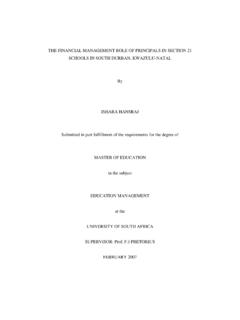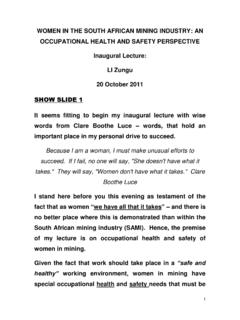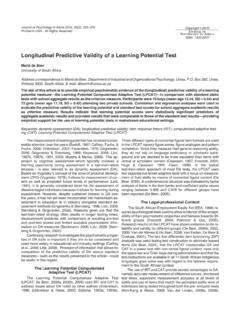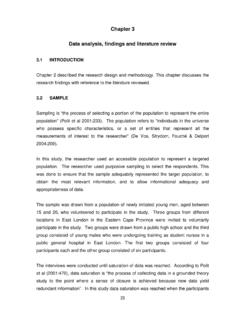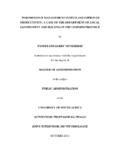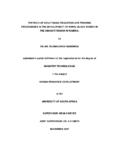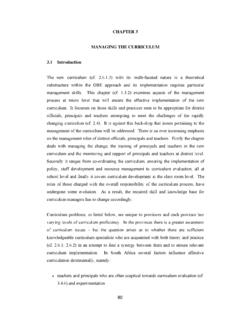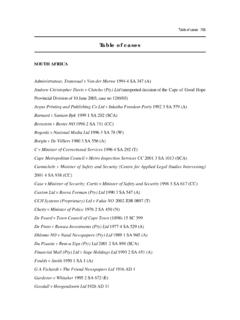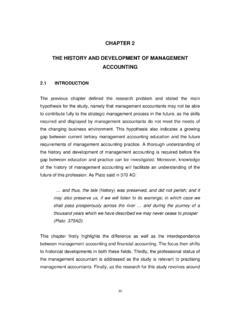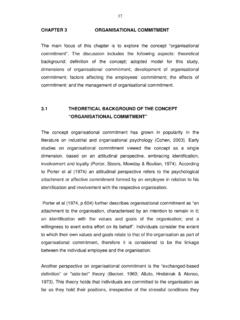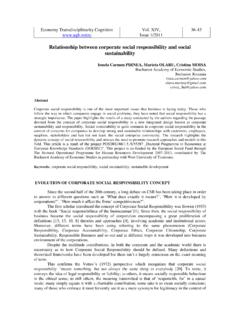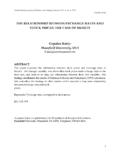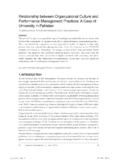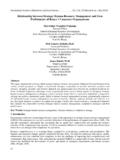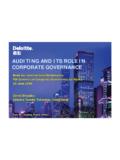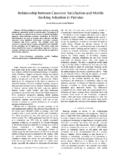Transcription of THE RELATIONSHIP BETWEEN EMPLOYEE …
1 THE RELATIONSHIP BETWEEN EMPLOYEE motivation , JOB SATISFACTION AND corporate CULTURE. by WANDA ROOS. submitted in part fulfilment of the requirements for the degree of MASTER OF SCIENCE. in the subject PSYCHOLOGY. at the UNIVERSITY OF SOUTH AFRICA. SUPERVISOR: MS R VAN EEDEN. JUNE 2005. Student number: 3381-990-4. I declare that The RELATIONSHIP BETWEEN EMPLOYEE motivation , job satisfaction and corporate culture is my own work and that all the sources that I have used or quoted have been indicated and acknowledged by means of complete references. _____ _____. Mrs W Roos June 2005. ACKNOWLEDGEMENTS. I wish to thank: - my supervisor, Mrs R Van Eeden, for her competent guidance;. - the host organisation for the participation of their staff in the study;. - SHL for the processing of the data and assisting with its interpretation;. - RAU Statcon for the statistical analysis of the data;. - my Mother for editing the research report in her professional capacity.
2 - my parents, brother and sister for their wonderful encouragement and support;. but most of all, my gratitude is to God, for carrying me through one of the most difficult undertakings of my life. SUMMARY. The aim of the study was two-fold: Firstly, the relationships of job satisfaction with the dimensions of EMPLOYEE motivation (energy and dynamism, synergy, intrinsic and extrinsic motives) and the domains of corporate culture (performance, human resources, decision-making and relationships) was investigated. Secondly, the relationships of EMPLOYEE motivation , job satisfaction and corporate culture with a number of demographic variables (age, gender, tenure, education level and seniority) were explored. The findings indicated a statistically significant three-way RELATIONSHIP BETWEEN EMPLOYEE motivation , job satisfaction and corporate culture, within which several aspects of these constructs contributed more powerfully towards the RELATIONSHIP than others.
3 The age, gender, tenure, education level and seniority of employees were also shown to influence EMPLOYEE motivation , job satisfaction and corporate culture. CONTENTS. LIST OF FIGURES. LIST OF TABLES. SUMMARY. 1. CHAPTER 1: INTRODUCTION 1. Problem statement 2. Brief definitions of the EMPLOYEE motivation , job satisfaction and corporate culture constructs 4. Organisational challenges in the marketing research industry 5. Objectives 6. Research paradigm 7. Research methodology 8. Layout of the dissertation 9. Chapter summary 9. 2. CHAPTER 2: THEORIES ON motivation , JOB SATISFACTION. AND corporate CULTURE 10. motivation 12. Historical development of the EMPLOYEE motivation concept 12. Definitions of EMPLOYEE motivation 16. Theories of motivation 21. Needs-based theories 23. Cognitive theories 30. Reinforcement theories 34. motivation theories: Composite summary 35. Job satisfaction 37. Definitions of job satisfaction 38. The determinants of job satisfaction 40.
4 Theories on job satisfaction 46. iv Job satisfaction: Composite summary 48. corporate culture 49. Historical development of the corporate culture perspective 50. Definitions of corporate culture 54. corporate culture : Composite summary 58. Relationships BETWEEN the constructs of EMPLOYEE motivation , job satisfaction and corporate culture 58. Chapter summary 63. 3. CHAPTER 3: LITERATURE REVIEW ON THE RELATIONSHIPS. BETWEEN EMPLOYEE motivation , JOB SATISFACTION AND. corporate CULTURE 64. Relationships BETWEEN demographic variables and EMPLOYEE motivation and job satisfaction 64. Relationships BETWEEN demographic variables and EMPLOYEE motivation 65. Relationships BETWEEN demographic variables and job satisfaction 69. Correspondence in the relationships BETWEEN demographic variables and EMPLOYEE motivation and job satisfaction 74. Relationships BETWEEN EMPLOYEE motivation , job satisfaction and corporate culture 76. Relationships BETWEEN EMPLOYEE motivation and job satisfaction 77.
5 Relationships BETWEEN job satisfaction and corporate culture 85. The three-way RELATIONSHIP BETWEEN EMPLOYEE motivation , job satisfaction and corporate culture 93. Chapter summary 94. 4. CHAPTER 4: RESEARCH METHODOLOGY 95. Research design 95. Research aims 96. Sample 96. Measurement instruments 96. Sampling and sample structure 97. v Sampling 97. Sample structure 98. Measurement instruments 100. The motivation Questionnaire (MQ) 100. The Experience of Work and Life Circumstances Questionnaire (WLQ) 106. The corporate Culture Lite Questionnaire (CCQ Lite) 110. Data collection and processing 120. Data analysis and interpretation 121. Chapter summary 122. 5 CHAPTER 5: PRESENTATION OF RESULTS 123. Reliability of the measurement instruments 123. Reliability of the motivation Questionnaire (MQ) 124. Reliability of the Experience of Work and Life Circumstances Questionnaire (WLQ) 126. Reliability of the corporate Culture Lite Questionnaire (CCQ Lite) 126. Summary 128.
6 Descriptive statistics of the measurement instruments 128. Descriptive statistics for the MQ 128. Descriptive statistics for the WLQ 131. Descriptive statistics for the CCQ Lite 132. Summary 134. The influence of demographic variables on EMPLOYEE motivation , job satisfaction and corporate culture 134. Age 135. Gender 136. Job tenure / Years of service 139. Education level 140. Seniority 141. Summary 144. Correlations within and BETWEEN dimensions, domains and scales of the questionnaires 145. vi Correlations within the MQ 146. Correlations within the WLQ 149. Correlations within the CCQ Lite 150. Correlations BETWEEN the MQ, WLQ and CCQ Lite 152. Canonical correlations BETWEEN the MQ, WLQ and CCQ Lite 154. Correlation BETWEEN the MQ dimensions and WLQ scales 154. Correlation BETWEEN the WLQ scales and CCQ Lite domains 156. Correlation BETWEEN the MQ dimensions and CCQ Lite domains 158. Summary 159. Chapter summary 161. 6 CHAPTER 6: DISCUSSION OF RESULTS 162.
7 Reliability of the measurement instruments 162. Descriptive statistics of the measurement instruments 162. The influence of demographic variables on EMPLOYEE motivation , job satisfaction and corporate culture 165. Age 165. Gender 166. Tenure 167. Education level 168. Seniority 169. Summary 170. Correlations within and BETWEEN the dimensions, scales and domains of the questionnaires 172. Relationships BETWEEN EMPLOYEE motivation , job satisfaction and corporate culture 173. Relationships BETWEEN EMPLOYEE motivation and job satisfaction 174. Relationships BETWEEN job satisfaction and corporate culture 175. Relationships BETWEEN EMPLOYEE motivation and corporate culture 177. Summary 178. Chapter summary 179. vii 7 CHAPTER 7: CONCLUSIONS AND RECOMMENDATIONS 180. Problem statement 180. Brief overview of research methodology 181. Conclusions and recommendations regarding the influence of demographic variables on, and the three-way RELATIONSHIP BETWEEN EMPLOYEE motivation , job satisfaction and corporate culture 182.
8 The RELATIONSHIP BETWEEN demographic variables and EMPLOYEE motivation , job satisfaction and corporate culture 182. The RELATIONSHIP BETWEEN EMPLOYEE motivation , job satisfaction and corporate culture 186. Summary 187. Contribution of the study towards psychological and organisational knowledge 188. Limitations of the study 188. Further research 189. Chapter summary 189. REFERENCES 190. ANNEXURE A. ANNEXURE B. ANNEXURE C. ANNEXURE D. viii CHAPTER 1. INTRODUCTION. Companies are made up of individuals organised in functional groups to attend to the business at hand. Some companies are successful and some are not. In their study of numerous American companies, Peters and Waterman (1982) found that a tight, culturally driven set of properties, which included rigidly shared values, invariably marked the 43 successful companies they focused on. They pointed out that the commitment of these companies' employees to their organisations' values and beliefs constituted a crucial factor in the success of these companies.
9 Becker (1975. in Peters & Waterman, 1982) provided some theoretical underpinning to this phenomenon, by stating that people are motivated by an essential dualism , which simultaneously drive them to need to be conforming members of a winning team, and to want to be stars in their own right. From Peters and Waterman's (1982) work it appeared that winning organisations display cultures that satisfy these dichotomous needs of the individuals who together make up those companies. The idea of the centrality of culture to organisations has been given considerable credence by the highly successful application of the Mc Kinsey 7-S model of corporate excellence in business management. The model was developed by Peters and Waterman (1982), and placed culture (shared beliefs) in the centre of what they believed to be seven crucial factors to organisational success. The other factors included structure, systems, style, staff, skills and strategy. Numerous other authors, such as Alvesson (2002), Alvesson and Berg (1992), and Cooper, Cartwright and Earley (2001) regard the cultural perspective as an inspiring way to study and understand organisational functioning.
10 Taking its inspiration from the work of authors such as those mentioned above, this study aimed to explore the marketing research type of organisation from a cultural angle, with the specific purpose of assessing the RELATIONSHIP BETWEEN an organisation's culture and the levels of job satisfaction and work motivation 1. experienced by those who ultimately render it successful or unsuccessful, namely its employees. Problem statement A myriad of studies have been conducted on EMPLOYEE motivation , job satisfaction and corporate culture, as well as on various combinations thereof. As far as could be ascertained, the RELATIONSHIP BETWEEN all of these constructs has, however, not been reported on in the same study as yet. In this regard, this study aimed to add to the body of knowledge in this particular domain of organisational psychology. According to Schofield (1998), an authoritative study conducted by the Sheffield Effectiveness Programme (a joint research project BETWEEN the Centre For Economic Performance at the London Stock Exchange and the Institute For Work Psychology at the University Of Sheffield) BETWEEN 1991 and 1998 has shown decisively that the way people are managed has a powerful impact on both productivity and profitability.
